

Home - YouCubed. 9 Strategies for Motivating Students in Mathematics. Motivating students to be enthusiastically receptive is one of the most important aspects of mathematics instruction and a critical aspect of any curriculum. Effective teachers focus attention on the less interested students as well as the motivated ones.
Here are nine techniques—based on intrinsic and extrinsic motivation—that can be used to motivate secondary school students in mathematics. Extrinsic and Intrinsic Motivation Extrinsic motivation involves rewards that occur outside the learner’s control. These may include token economic rewards for good performance, peer acceptance of good performance, avoidance of “punishment” by performing well, praise for good work, and so on. Assessment. From Term 1 2017, Victorian government and catholic schools will use the new Victorian Curriculum F-10.

This page is currently being reviewed and may be subject to change. For more information on the curriculum, see: The Victorian Curriculum F–10 - VCAA. Promoting growth mindset and effort in mathematics classrooms. In the second of two reader submissions about the Motivated Minds partnership between La Salle Academy Lithgow and Charles Sturt University, Associate Professor Jane Mitchell, Associate Professor Sara Murray and Jeffrey Larsen share a feedback strategy to encourage students to make a consistent effort in mathematics class, and to help them see a connection between their effort and achievement.
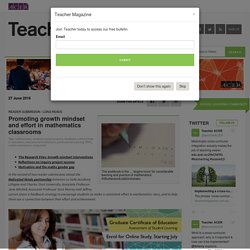
Students with a fixed mindset believe that intelligence or ability is an unchangeable entity; while those with a growth mindset think of intelligence or ability as a malleable quality that can be incrementally developed through effort. Students with a fixed mindset think that intelligent people excel at schoolwork effortlessly. When schoolwork becomes difficult, students with a fixed mindset often struggle, or give up.
In some cases, these students are reluctant to make an effort because they do not think they can improve their learning. The teacher as a facilitator and resource person. In the final instalment of his 10-part series on real-world maths, Dave Tout looks at the role of the teacher as a facilitator and resource person.
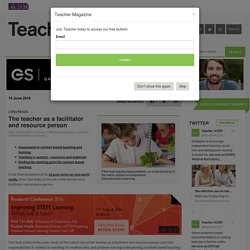
This final article in the series looks at the critical role of the teacher as a facilitator and resource person and their responsibilities in relation to teaching the mathematics and problem-solving underpinning a context-based teaching approach. Of course, the ultimate purpose of all this planning is that the students undertake the investigation and learn and apply a range of knowledge and skills.
In order for students to successfully achieve the learning and outcomes expected it is vital that the teacher monitors their progress and intervenes when necessary to teach any identified mathematics and problem-solving skills that are necessary or missing for the task being tackled. These can be introduced in a number of ways, depending on the skills and experience of the students. Is it better to teach pure math instead of applied math?
Abstract, pure math — solving disembodied equations filled with x’s and y’s — can often seem boring.

Creative math teachers commonly try to come up with concrete, real-world examples to motivate students and make math relevant to adolescents. But a new report from the Organization for Economic Cooperation and Development (OECD) finds that applied-math instruction, or the way it is actually taught in classrooms, may not be serving students well. Connecting Math to Real-World Tasks. When I started teaching, I remember being overwhelmed by the many things I was “supposed” to do during a lesson.
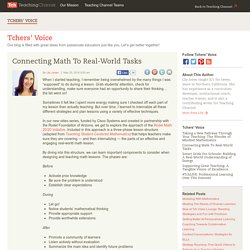
Grab students’ attention, check for understanding, make sure everyone had an opportunity to share their thinking… the list went on! Sometimes it felt like I spent more energy making sure I checked off each part of my lesson than actually teaching. But over time, I learned to internalize all these different strategies and plan lessons using a variety of effective techniques. In our new video series, funded by Cisco Systems and created in partnership with the Rodel Foundation of Arizona, we get to explore the approach of the Rodel Math 20/20 Initiative. Taking A New Pathway Through Your Teaching: The Wonder Of Mindset Mathematics. Imagine going to school each day and entering a classroom filled with students who are eager to explore mathematical ideas, willing to embrace failure and struggle, and persistent with any math problem you give them.
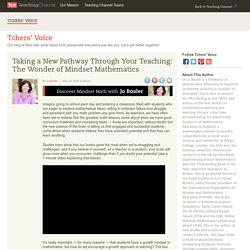
As teachers, we have often been led to believe that the greatest math lessons come about when we have good curriculum materials and interesting tasks — those are important, without doubt, but the new science of the brain is telling us that engaged and successful students come about when students believe they have unlimited potential and that they can learn anything. Studies even show that our brains grow the most when we’re struggling and challenged, and if you believe in yourself, as a teacher or a student, your brain will grow more when you encounter challenge than if you doubt your potential (see a 1-minute video explaining that below). Looking For Math Resources? Kristin Gray Has a Pinterest Board For You. At any given time, my computer has at least ten open tabs in my Google Chrome web browser.
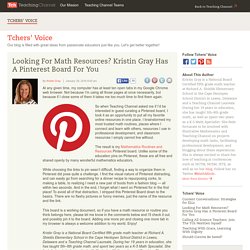
Not because I’m using all those pages at once necessarily, but because if I close some of them it takes me too much time to find them again. So when Teaching Channel asked me if I’d be interested in guest curating a Pinterest board, I took it as an opportunity to put all my favorite online resources in one place. A 21st Century curriculum. Image © Shutterstock/ Monkey Business Images In my recent Teacher article ‘Big five’ challenges in school education I argue that one of the biggest challenges we face in school education is to identify and develop the knowledge, skills and attributes required for life and work in the 21st Century.
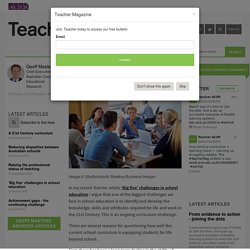
This is an ongoing curriculum challenge. There are several reasons for questioning how well the current school curriculum is equipping students for life beyond school. Challenging students in maths. ‘The emphasis is that the students are the ones doing the learning, not the teachers doing the teaching.’ – Professor Peter Sullivan commenting on his work with the Catholic Education Office of Parramatta.

In this video, Teacher readers get an inside look at a program that is helping educators in New South Wales increase the challenge – and the expectations – of students in mathematics. Strategies include getting students to work on whiteboards to ensure their thinking is visible and proposing tasks that they don’t know how to do, with the teacher introducing the task effectively, providing prompts and extending their thinking. In the video, Ciara Duffy, Leader of Learning at St Clare’s Catholic High School in Hassall Grove, explains that the program is much more student-centred. 7 Ways To Drop The Mic In Math Class. I like to think I’m an entertaining story-teller.
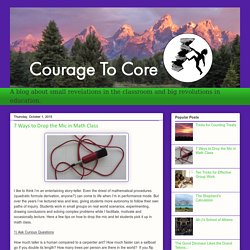
Even the driest of mathematical procedures (quadratic formula derivation, anyone?) Targeting content to individual skills. In this series of articles related to teaching maths in context, I have attempted to map out a staged process on how you can plan to teach where the maths is embedded in the real world. The previous articles discussed the challenges and processes of meeting the needs and interests of students in order to engage them, and in this article I address how to go through the crucial underpinning task of identifying the maths skills and content to be targeted. This stage involves two processes: 60 Smarter Ways To Use Google Classroom. 60 Smarter Ways To Use Google Classroom by TeachThought Staff Google Classroom is quietly becoming the most powerful tool in education technology. It may lack the visual appeal of iPads, or the student credibility of a BYOD program.
A premier source of classroom tested, Internet-based economic lesson materials for K-12 teachers and their students. Many economics and personal finance concepts overlap with math curriculum, but economics and personal finance teachers are not trained to teach complex calculations and formulas, and math teachers may not focus on the personal finance and economic applications. Tackling the school industry mathematics divide. This article consists of edited extracts from Identifying and Supporting Quantitative Skills of 21st Century Workers: Final Report. Prepared by the Australian Association of Mathematics Teachers and the Australian Industry Group, © Commonwealth of Australia 2014. The teaching of mathematics in secondary schools and the use of mathematical skills in the workforce are very different. Students who are mathematically capable at school often have difficulty transferring this ability to the workplace.
Problem-Solving Skills From MindTools.com. Alpha: Computational Engine. Curriki - Open Educational Resources. Traditionally one of the loathsome subjects, math is often a stumbling block for students. Curriki’s Project-Based Learning (PBL), Common Core Aligned Geometry curriculum will help your students build the skills and confidence that will help them conquer any mathematical problem and develop 21st century skills such as communication, collaboration, and teamwork.
Project-Based Learning in Math: 6 Examples. Our Lessons » Hungry Teacher. Our Lessons » Hungry Teacher. 10 Web Resources For Learning How To Code. Conceptis logic puzzles - Have fun, get smart! Recreational and Educational Value of Math Puzzles. The figure above shows a puzzle called OkiDoku. Prof. Dani Novak & Prof. David Rosenthal, Ithaca College Many people enjoy working on grid puzzles as small, quick challenges of their mathematical and logical skills. Algebra. We work with domain experts to curate and organize high quality, openly licensed content.
This content comes from government resources, open educational repositories, and other openly licensed websites. The result is a great free online learning resource. Free PDF download — Get the Boundless Algebra Open Textbook, including all of our Algebra college level content in a convenient PDF ebook format. Infographic: When Am I Ever Going to Use This Math?
VCE Further Maths Help. Boundless - Algebra. Understanding The Role Of Collaborative Educational iPad Games. In the modern classroom, teachers are always looking for ways to make learning fun and interesting. iPads, games, eLearning platforms and BYOD are all on the menu…. and let’s face it, technology (from DVD players to iPads) can make life a lot easier in the classroom. The adoption of iPads in classrooms across the globe has significantly changed the way teachers think about teaching (at all levels). Most educators who have used iPads in the classroom now opt for a blended learning approach, using tablets, games and learning aids (like interactive whiteboards) as a way to engage students and support traditional teaching methods. The SAMR model suggests that the use of any new technology can either completely transform, redesign or enhance existing methods of learning.
My best lesson: turning maths pupils into second world war codebreakers. Home Page. Online maths practice and lessons. Maths Games For Kids - Making Maths Fun. YAY MATH! Algebra Geometry Math Videos Online.